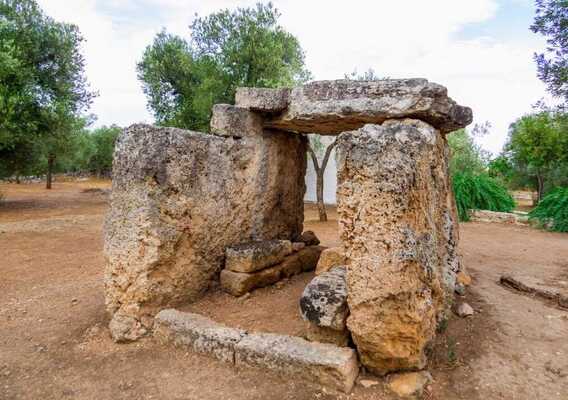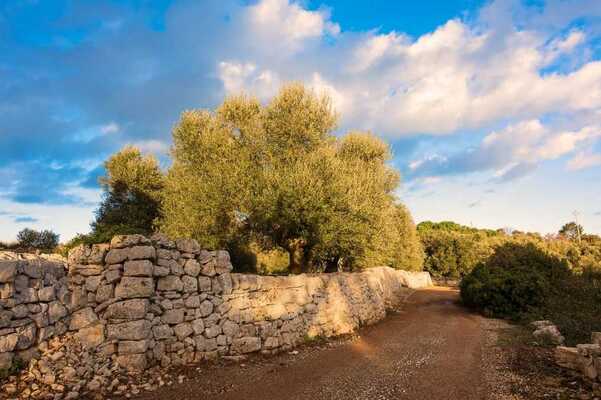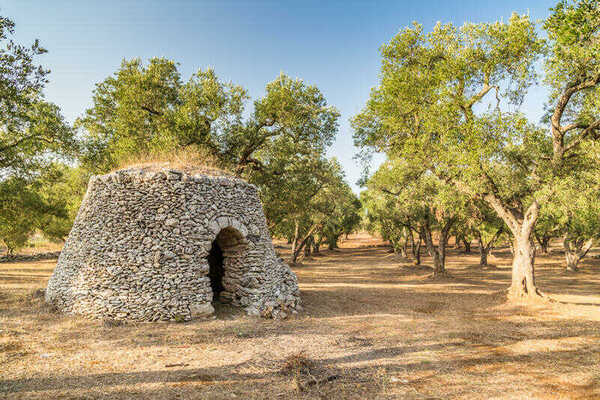The Menhirs in Salento
Silent witnesses of the first expressions of human feeling, of a past that did not yet know the Messapic civilization, are the Menhirs scattered throughout Salento, whose origin and function remain shrouded in an aura of mystery.
Erected starting from the Neolithic, the Menhir is a type of megalithic monument consisting of a monolithic column, of an almost geometric or irregular shape, mostly left rough, fixed vertically in the ground, also called Pietrafitta, no more than 5 meters high.

The function of the Menhirs in Salento
- This megalithic path is illuminated by legends, as there is still no certain and entirely plausible explanation for their function. It is thought they served as “signposts” of tombs of extraordinary importance.
- Many do not exclude the significance of real monuments dedicated to the dead or to divinities, especially since many still show traces of anthropomorphic sculptures, the so-called “alignments” which could be gathering places or sacred streets.
- Other currents would like the broad faces of the stone, oriented from east to west, illuminated by the sun to be used to mark time and mark the solstices and equinoxes, or identify them as simulacra of the fertility cult of the mother goddess earth.
- What is certain is that in the Middle Ages they were aimed at the “Christianization” of the menhirs, through the affixing of the cross on the facades of the structure. From here they became the shared heritage of Christianity and even today in some villages of Salento, they are chosen as the destination of the Palm Sunday procession to stop and bless the olive twigs.
- Mystery and doubts have always invaded the world of Menhirs in Salento: if it is not clear which people had erected them and for what purposes. It is possible that the places where the Menhirs were built were considered suitable for establishing contact with the otherworldly world and the Gods.
A link between past and present that is preserved by a multifaceted land that brings together culture, nature, folklore and history disseminated by testimonies of different and ancient peoples; an original, inexplicable sacredness that we live with every day.
Where are the Mehnir found in Salento?
Traces of these “elderly” stones in many countries of the world: France, British Isles, North Africa, Germany.
Among the Italian regions, Puglia is certainly the richest in such megaliths. In fact, there are approximately 120 located in the coastal area of Bari, an area north of Taranto and in Salento.
These “sacred stones” are concentrated in the area between Minervino, Giurdignano, Giuggianello, Martano and Otranto.
- In Giurdignano, defined as the “megalithic garden of Italy”, there are more than 15 examples, we highlight: the “Madonna of Constantinople” (3 meters high, in Lecce stone); “Monte Tongolo” (discovered in 1951); the two “Vico Nuovo”; the “Croce della Fausa” (from the name of the adjacent cave); the “San Vincenzo” (one of the tallest); the “Palanzano”; the “Madonna del Rosario” (transformed into a votive column with an octagonal plan); the two “Vicinanze” (so called from the name of a nearby rock farmhouse). Another menhir worthy of note is certainly the “San Paolo” which takes its name from the saint to whom the Byzantine crypt on which it stands is named. One of the lowest (about 2 metres) bears the signs of Christianisation in that hole on the top which, it is thought, housed the cross.
- Moving to Giuggianello, we will find the “Polisano” menhir and the “Quattromacine” (in Lecce stone).
- In Martano there is one of the highest Menhirs in Italy, the “Menhir de Santu Totaru“, which reaches 4.70 meters in height.
- 7km from Otranto, on the Serra di Monte Vergine, stands the menhir of the same name, as is the sanctuary that rises at the top of the hill.

The Dolmens in Salento
It is difficult to explain the overwhelming love for this extraordinary place, a land made of landscapes, colors and mysteries: Salento which has very ancient, even prehistoric, roots. We start precisely from the 4th millennium BC. with the birth of the Dolmen in the Salento area.

Dry stone walls in Puglia
Among the many peculiarities that characterize the Salento landscape and Puglia in general, there are undoubtedly the dry stone walls. These walls give all visitors one of the most authentic faces of Salento such that they immediately understand where they are. The creators of the "dry stone walls", who handed down this art form through the centuries, were certainly the descendants of the Messapians and the Neoliths.

The “Pajare” in Salento
The Pajare also called "caseddhi", but also "pagghiari" or "furni" are particular typical buildings present in Salento and are considered typically rural homes and built with the dry wall technique. Furthermore, they respect the standards of green building because the use of natural materials such as stone does not affect the environment, becoming a true engineering marvel.

